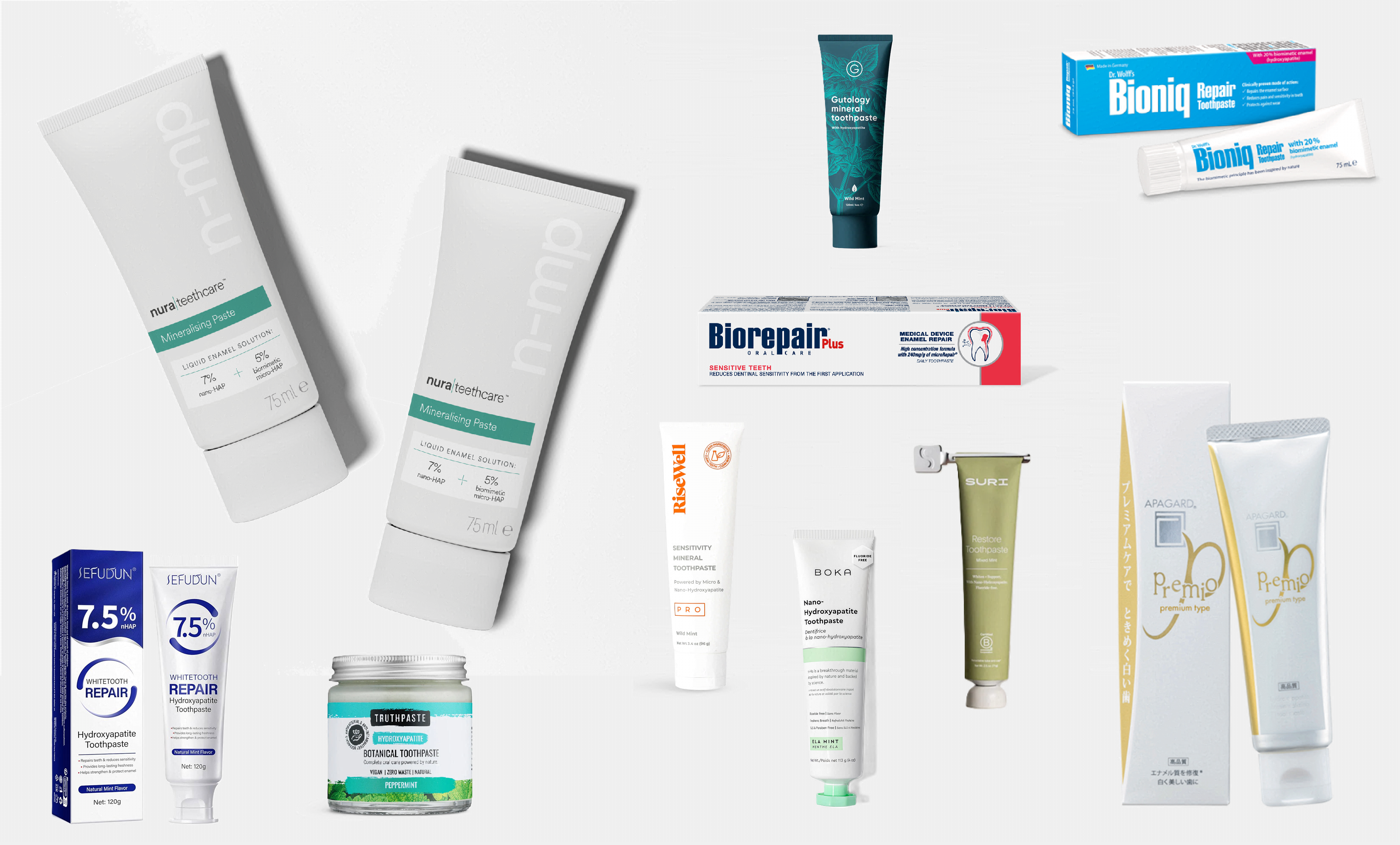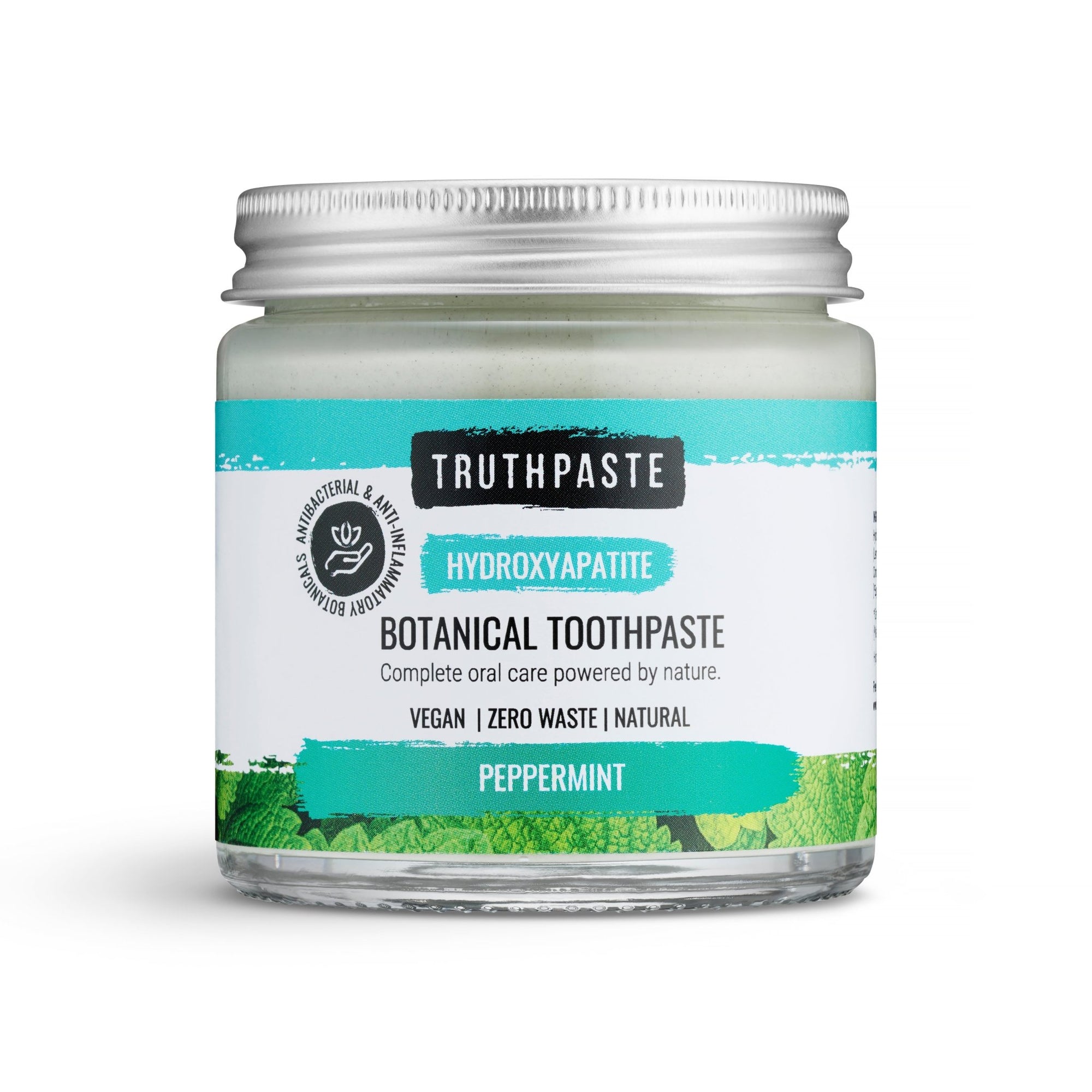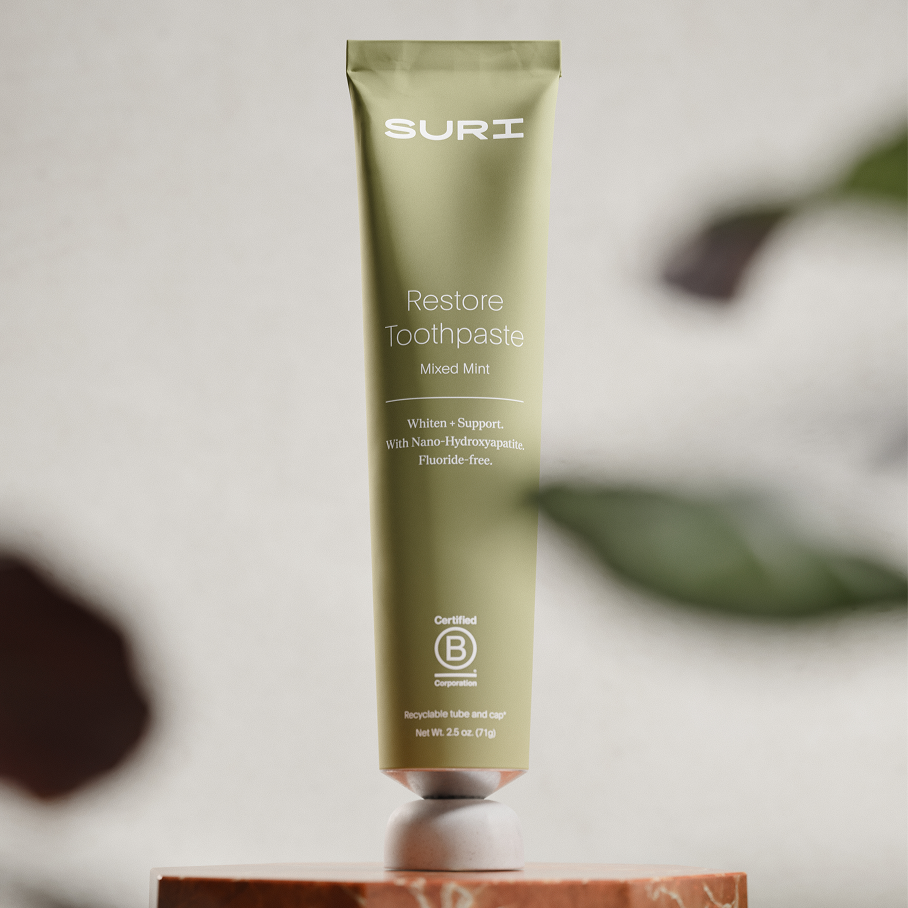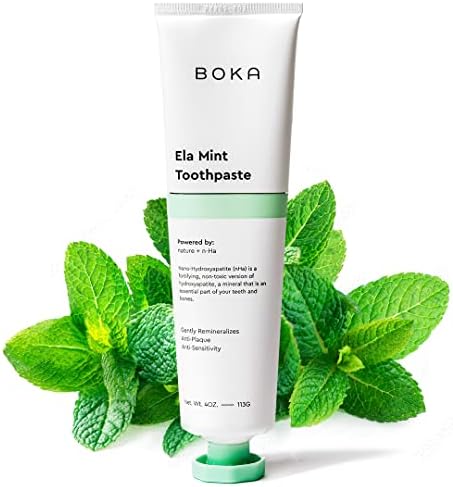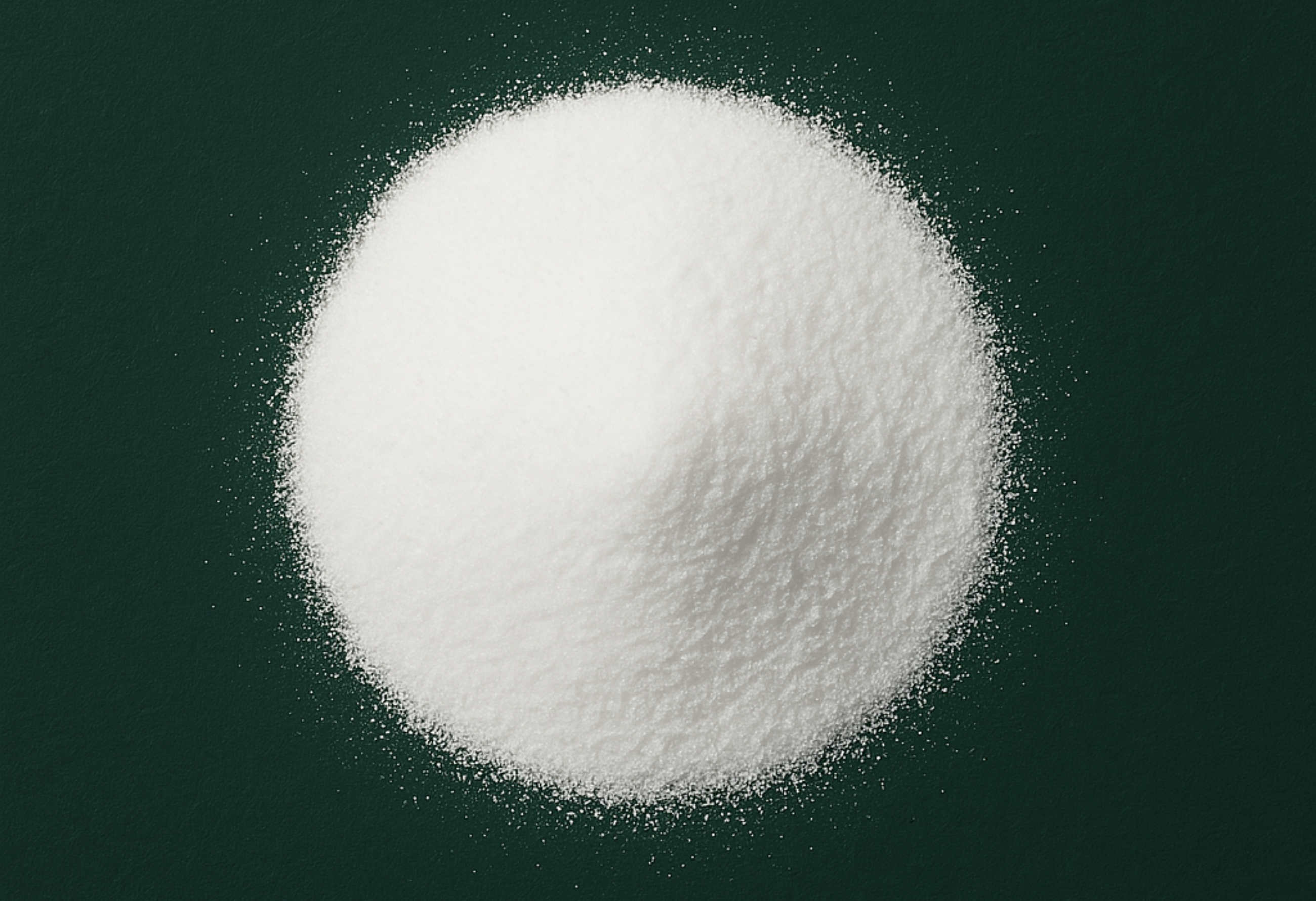Discover the best fluoride-free hydroxyapatite toothpastes in the UK, prioritised by % HAP, nano-HAP content, and published scientific data.
What is Hydroxyapatite (HAP)?
What is Hydroxyapatite
Hydroxyapatite (HAP) is the natural mineral your teeth are made of — around 97% of enamel and most of dentin. In toothpaste, HAP replenishes lost mineral, sealing tiny defects, reducing sensitivity, and restoring surface smoothness for a healthier, brighter look.
Why does concentration (%) of HAP matter?
Dating back to the 2000s, studies have shown that 10% HAP is needed to for equivalent repair as fluoride. Despite this many brands use concentrations of less than 2% in an effort to cut costs whilst still being able to name it as an ingredient. Low, undisclosed concentrations risk “pixie-dusting” — too little HAP to deliver measurable results.
What is the difference between nano-HAP and micro-HAP?
Nano-HAP particles are small enough to enter micro-pores and dentine tubules, supporting subsurface repair and sensitivity relief. Micro-HAP reinforces and polishes the surface; using both targets deep repair and surface strength together.
Why not combine fluoride and HAP? Research from Nura Teethcare found that when Hydroxyapatite and Fluoride are combined, they can react and calcify in ways that reduce efficacy — so in this guide we only include fluoride-free HAP toothpastes.
How we ranked:
-
% HAP concentration stated (higher is better)
-
Particle size & type (nano-hydroxyapatite earns more credit for subsurface repair and sensitivity relief; but micro-/biomimetic HAP still has benefits with surface reinforcement. Both together is best)
-
Transparency (does the brand disclose the % and particle type?),
-
Published results (has the brand actually tested the efficacy of their product, and even better benchmarked it against vs Fluoride?)
-
Formula quality (unnecessary additives, abrasivity, and microbiome friendliness)
Top Toothpastes

1) Nura Mineralising Paste — 12% HAP (Nano + Micro)
Nura is the only paste here disclosing a full 12% HAP (with both nano- and micro-HAP) and publishing independent head-to-head results vs fluoride toothpaste. Nura is backed by robust science, and has been tested by world-leading researchers at the University of Milan.
Pros
-
High load (12%) + dual particle sizes for surface repair and deeper integration.
-
Independent testing (University of Milan) with >2× enamel repair vs the world’s #1 fluoride toothpaste brand.
-
Fully fluoride-free; built around the HAP mechanism.
-
Uses the only nano-HAP certified as safe in the EU.
Cons
-
Premium price point vs commodity pastes. (Value comes from % HAP + testing.)
Best for: People who prioritise performance, want the strongest HAP concentration with published head-to-head data.
Where to buy: Available in the UK and Europe on Nura's website, here.
2) Apagard Premio (Sangi) — high-concentration nano-HAP
Apagard (Sangi) practically invented nano-HAP for oral care. Premio is their highest-strength variant; while Sangi doesn’t publish an exact % for Premio, it is reported in scientific papers to contain 10%. Its FAQ states no difference vs fluoride in caries prevention (equivalence).
Pros
-
Flagship Apagard with highest nHAP concentration within the line.
-
Long heritage of HAP research, with multiple published research papers.
-
Brand-published stance that HAP is as effective as fluoride for caries prevention (equivalence).
Cons
-
Exact % not officially disclosed by Sangi (commonly reported ~10%).
-
Expensive and not widely available in the UK, as must be imported.
Best for: Buyers who want a top-tier Japanese nHAP paste with long-running research behind it.
3) Dr. Wolff — Bioniq® Repair
Dr. Wolff’s BioHAP line (Bioniq, KAREX) is fluoride-free and well-studied. Their research hub highlights comparative studies showing HAP performs on par with fluoride for remineralisation and plaque/gum outcomes. Contains 20% micro-HAP, but no nano-HAP
Pros
-
Published head-to-head HAP vs fluoride data (non-inferiority/equivalence).
-
Widely available in the UK.
Cons
-
No nano-HAP. Relies solely on one type of micro-HAP.
Best for: Anyone wanting a cost-effective fluoride-free toothpaste.
4) Biorepair (Coswell) — (micro-HAP with Zinc)
Biorepair is a pioneer of what they call zinc-substituted micro-HAP (microRepair®). The brand has published research papers showing the how their toothpaste performs, but clear head-to-head studies vs fluoride appear thinner than Nura, Sangi and Dr. Wolff. Percent HAP is not clearly disclosed on the official pages.
Pros
-
Established micro-HAP tech (microRepair®) with varied products (sensitivity, whitening, kids).
Cons
-
No official % disclosure;
-
Limited direct fluoride comparisons. Some papers questions efficacy.
Best for: Budget-friendly Hydroxyapatite seekers.
5) RiseWell PRO (Adults/Kids) — (Micro + Nano)
RiseWell’s PRO line includes nano-HAP. We didn’t find independent, product-specific testing data published by RiseWell.
Pros
-
Combines nano and micro-Hydroxyapatite.
- Fluoride-free; kid and adult variants.
Cons
-
No published results on product performance, or direct fluoride comparison.
-
Availability/pricing can vary in the UK.
Best for: Shoppers who enjoy trying US brands.
6) Gutology Hydroxyapatite Toothpaste — Probiotic and micro-HAP
UK brand with a microbiome-friendly positioning, fluoride-free and biomimetic HAP. The official site doesn’t state a %. Amazon listings note “we don’t use nano”. No brand-published fluoride head-to-head.
Pros
-
Fluoride-free, simple INCI with HAP high in the list;
-
Microbiome-friendly angle, with combination pf prebiotics and probiotics.
Cons
-
No % disclosure.
-
No nano-HAP.
-
No testing data available, or comparison to fluoride efficacy
Best for: Those seeking micro-biome friendly formulas, actively avoiding nano particles and wanting a UK-based, gentle formula.
7) Truthpaste Peppermint — 5% micro-HAP
Truthpaste focuses on using fully natural ingredients, combining 5% micro-HAP with a range of botanicals.
Pros
-
Discloses percentage of HAP.
- Unique, fully natural formula.
Cons
-
Comes in below 10% threshold
- Glass jar packaging exposes product to air, and could harbour bacteria.
Best for: Eco and natural-centric users, who are happy with non-foaming agents.
8) SURI “Restore” — Eco-friendly, but nano-HAP listed near the end of ingredients.
SURI is stylish and fluoride-free, but nano-HAP appears near the end of the ingredient list, suggesting a very low %. No disclosed percentage and no head-to-head vs fluoride. Elegant, fully recyclable aluminium tube. Pairs nicely with Suri's electric toothbrush, which is great.
Pros
-
Fluoride-free; SLS-free; elegant user experience.
- Recyclable metal tube and plant-based plastic heads.
Cons
-
n-HAP is near the end of INCI (likely very low concentration)
-
No published data on efficacy.
-
Contains titanium dioxide
Best for: Fans of the SURI ecosystem who prioritise aesthetic feel and eco credentials.
9) Boka Ela Mint / n-HA range — nano-HAP, % not disclosed
Boka is popular and fluoride-free with nano-HAP, but doesn’t state % on product pages; no product-specific head-to-head vs fluoride. Features many popular flavours.
Pros
-
Widely liked flavours and textures.
Cons
-
No % disclosure; no published fluoride comparison.
Best for: People who want varied flavours and nice aesthetic.

10) Chinese Amazon Brands — Illegal and potentially dangerous nano-HAP
Products claim to contain high levels of nano-HAP, such as 7.5% or 9.9% nano-Hydroxyapatite, however are imported from China with no regulation of nano particles. Unknown dangers.
Pros
-
High claimed percentage of nano-HAP
Cons
-
Use Chinese, unregulated nano particles. Studies show that 'needle' shaped nano-HAP particles can be potentially dangerous.
Best for: Those who want cheap, high concentration HAP toothpastes, and don't worry about potential dangers of un-regulated nano particles.
Final take
-
If you want maximum HAP performance with transparent data, Nura is the easy #1.
-
Apagard Premio slots cleanly at #2 thanks to its high nHAP focus and long-standing expertise in the space of Hydroxyapatite.
-
Dr. Wolff (Bioniq/KAREX) earns #3 on the strength of published equivalence and broad availability, but it doesn't contain any nano-HAP.
-
Everything else is ranked down based on undisclosed percentages, lack of nano-HAP, and lack of published data.
